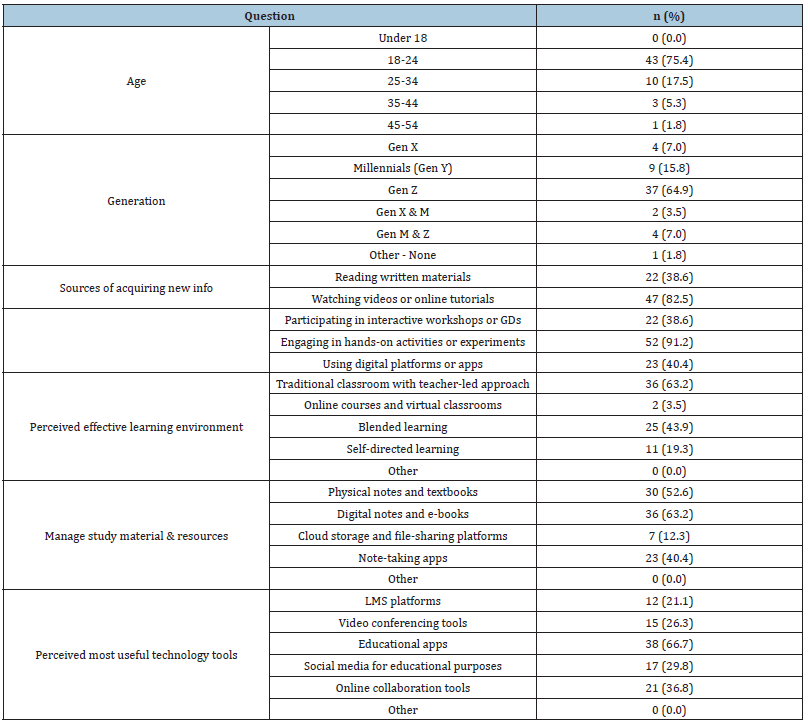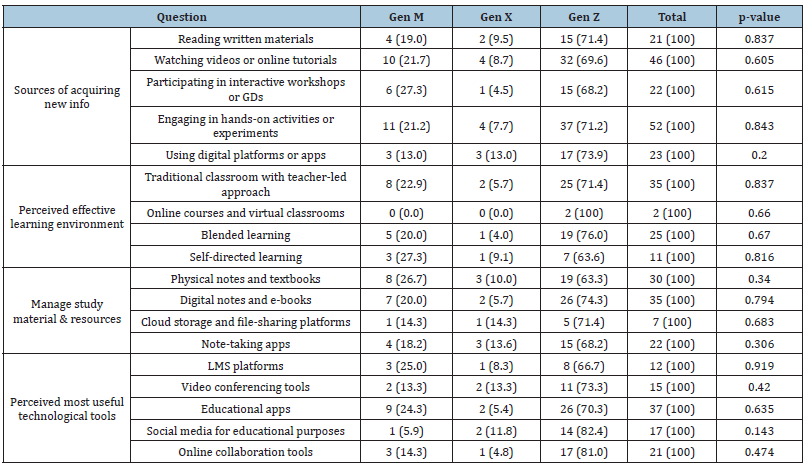- Submissions

Full Text
COJ Nursing & Healthcare
Exploring Generational Learning Preferences in Nursing Education: A Comprehensive Study
Joy Bliss PhD RN*
Faculty of Nursing and Public Health, Hawaii Pacific University, USA
*Corresponding author: Joy Bliss PhD RN*, Faculty of Nursing and Public Health, Hawaii Pacific University, USA
Submission: June 13, 2024;Published: July 05, 2024

ISSN: 2577-2007Volume9 Issue1
Abstract
This comprehensive study examines the learning preferences across different generational cohorts within the context of nursing education. The research utilizes a detailed survey, “Understanding Student Learning Preferences Across Generations,” to investigate how students from diverse generations-including the Silent Generation, Baby Boomers, Generation X, Millennials (Generation Y), Generation Z, and Generation Alpha-approach their educational experiences. This study collects demographic data along with preferences related to learning methods, environments, study material management, and the use of technological tools. The goal is to identify distinct generational preferences and trends that could be used in the development of more tailored and effective nursing education strategies. Ensuring the confidentiality and anonymity of participants, this study adheres to stringent ethical standards. The findings highlight the necessity of incorporating generational insights into the design and implementation of nursing education programs. By addressing the specific needs of each generational cohort, the study aims to enhance educational outcomes and effectively bridge the gap between traditional educational methodologies and current pedagogical demands. This initial work not only deepens our understanding of generational differences in learning preferences but also provides actionable insights for educators to optimize nursing curricula to meet the evolving needs of a diverse student body.
Keywords:Generational differences; Nursing education; Learning preferences; Educational strategies; Cross-Generational teaching
Abbreviations:CNE: Continuing Nursing Education; SBL: Simulation-Based Learning
Introduction
In the dynamic field of nursing education, understanding and addressing generational differences in learning preferences is crucial. This comprehensive literature review explores studies that highlight how these preferences influence educational strategies and outcomes. Gursoy & Kuruüzüm [1] provide foundational insights into distinct learning preferences across generations, advocating for adaptable teaching strategies. Leach & Hurd [2] suggest practical teaching strategies tailored to these differences, promoting an integrative approach combining traditional and modern methods. They highlight the necessity of innovative methodologies to cater effectively to diverse learner needs within nursing education. The role of technology in bridging the generational divide cannot be overstated, as Davis & Carter [3] discuss how digital tools enhance engagement and learning across all student cohorts. These technologies facilitate a better connection between traditional educational practices and the expectations of newer generations who are more digitally inclined. Similarly, Smith & Robertson [4] note the varying efficacy of simulation-based learning, particularly among Millennials and Generation Z, who favor interactive environments. This aligns with the shift towards experiential learning, which has been shown to improve knowledge retention and engagement significantly.
Jones & Silver [5] examine the differential effectiveness of interactive learning tools across generations. Their findings suggest that while younger students are more receptive to high-tech learning environments, older generations may benefit from a blend of traditional and modern approaches to fully engage with the educational content. This is corroborated by Greenfield [6] and Taylor & Johnson [7], who highlight the effectiveness of adaptive teaching methods and the impact of case studies versus traditional lectures on examination outcomes. Moreover, the flipped classroom model as investigated by Wang & Jenkins [8] receives particular attention for its effectiveness among younger cohorts who prefer autonomous and self-directed learning environments. Adding to the richness of this review, Foecke [9] explores the application of generational theory in online continuing nursing education, emphasizing the need for educational strategies that are responsive to the varied preferences of multigenerational learners.
Further contributions by Barr & Miller [10] discuss generational teaching strategies, emphasizing the need for approaches that effectively engage students across various age groups within nursing programs. Chamberlain & Fetter [11] focus on adapting nursing curricula for the digital age, highlighting the integration of digital tools to meet the educational needs of younger generations while preserving effective methods for older students. Lastly, Edwards & Dirette [12] provide empirical data on how generational differences affect learning outcomes, offering insights into how educational strategies can be optimized to enhance the efficacy of nursing education. These studies collectively underscore the necessity for nursing education programs to adopt flexible, diverse educational strategies that accommodate the distinct learning preferences of a multi-generational student population. This shift towards more personalized and technologically enhanced education respects traditional educational values while embracing the pedagogical innovations demanded by today’s healthcare education landscape.
Statistical Analysis
The objective of the study is to test the relationship between demographic characteristics and learning preferences across different generations and to examine potential associations. Descriptive statistics were used to report frequencies and percentages for each category, providing a detailed sample profile of the participants. Chi-square tests were conducted to assess associations between generational identification and learning preferences. This statistical test is based on the Null Hypothesis (H0) of no association, while the Alternative Hypothesis (H1) suggests an association. Contingency tables were constructed for each preference, and Chi-square statistics and p-values were calculated, with p-values less than .05 indicating statistical significance. The data analysis was performed using SPSS, version 28.0.
Results
A sample of 29 and 28 students from two classes participated in the survey. The frequency distribution of demographic characteristics and learning preferences is presented in Table 1. The majority of respondents (75.4%) were 18-24 years old, followed by 17.5% aged 25-34, 5.3% aged 35-44, and 1.8% aged 45-54, with no participants under 18. For generational cohort identification, 64.9% of the participants identified as Gen Z, 15.8% as Millennials (Gen Y), 7.0% as Gen X, 3.5% as Gen X & Millennials, and 7.0% as Gen Y & Z. Table 2 presents a cross-tabulation of age-group and generational identification. A significant association was found (p<.001) between these two attributes. Specifically, a substantially high percentage (85.7%) of participants aged 18-24 identified as Gen Z. For the cross-tabulation analysis, participants identifying with two generations were combined into one generation by matching their age group with the correct generation type based on actual age. In terms of acquiring new information, 82.5% preferred watching videos or online tutorials, and 91.2% preferred engaging in hands-on activities or experiments. Reading written materials and participating in interactive workshops or group discussions were each preferred by 38.6% of the respondents, while 40.4% preferred digital platforms or apps.
Table 1:Frequency distribution of demographic and learning preferences.

Table 2:Cross-tabulation of Age group and generation type identified.

Regarding perceived effective learning environments, 63.2% preferred a traditional classroom with a teacher-led approach, 43.9% preferred blended learning, and 19.3% opted for selfdirected learning. Only 3.5% preferred online courses and virtual classrooms. For managing study materials and resources, 63.2% used digital notes and e-books, 52.6% relied on physical notes and textbooks, 40.4% utilized note-taking apps, and 12.3% used cloud storage and file-sharing platforms. Regarding the most useful technology tools, 66.7% identified educational apps as useful, followed by 36.8% who found online collaboration tools useful, 29.8% who utilized social media for educational purposes, and 26.3% who preferred video conferencing tools. Learning Management System (LMS) platforms were deemed useful by 21.1% of the respondents.
The cross-tabulation of learning preferences by generational identification (Gen X, Millennials, Gen Z) and the associated Chi-square test p-values are presented in Table 2. For sources of acquiring new information, preferences were distributed similarly across generations (Table 3). Reading written materials was selected by 71.4% of Gen Z, 19.0% of Millennials, and 9.5% of Gen X (p=0.837). Watching videos or online tutorials was preferred by 69.6% of Gen Z, 21.7% of Millennials, and 8.7% of Gen X (p=0.605). Hands-on activities or experiments were chosen by 71.2% of Gen Z, 21.2% of Millennials, and 7.7% of Gen X (p=0.843). The use of digital platforms or apps showed a slightly lower but still nonsignificant preference difference (p=0.200). In terms of perceived effective learning environments, traditional classroom approaches were preferred by 71.4% of Gen Z, 22.9% of Millennials, and 5.7% of Gen X (p=0.837). Blended learning was chosen by 76.0% of Gen Z, 20.0% of Millennials, and 4.0% of Gen X (p=0.670). Preferences for self-directed learning showed no significant generational difference (p=0.816).
Table 3:Cross table of learning preferences and generation.

Values in the parenthesis are percentages of the respective column totals.
For managing study materials and resources, digital notes and e-books were favored by 74.3% of Gen Z, 20.0% of Millennials, and 5.7% of Gen X (p=0.794), while physical notes and textbooks were used by 63.3% of Gen Z, 26.7% of Millennials, and 10.0% of Gen X (p=0.340). Note-taking apps were used similarly across generations (p=0.306). Regarding the most useful technological tools, educational apps were identified as useful by 70.3% of Gen Z, 24.3% of Millennials, and 5.4% of Gen X (p=0.635). Social media for educational purposes showed the greatest disparity, with 82.4% of Gen Z, 11.8% of Gen X, and 5.9% of Millennials favoring it (p=0.143). Overall, no significant associations were found between generational identification and learning preferences, indicating that learning preferences are consistent across Gen X, Millennials, and Gen Z.
Discussion and Implications
Generational Trends in Learning Preferences: The survey revealed diverse learning preferences among nursing students across different age groups and generations. While there were variations in preferences, certain trends emerged, such as a strong preference for hands-on activities and digital resources among younger generations. When considering technological integration in Learning; Educational apps emerged as the most preferred technological tool for learning among students in both classes, highlighting the importance of technology integration in nursing education. Video conferencing tools and social media platforms were also perceived as valuable resources, particularly among younger students. In classroom environment preferences: traditional classroom settings with teacher-led approaches were still preferred by a significant portion of students, indicating the importance of balancing traditional and modern teaching methods.
Implications
Nursing educators should recognize and accommodate diverse learning preferences among students, leveraging a variety of teaching methods and technological tools to enhance learning experiences. Integration of educational apps, video conferencing tools, and social media platforms can promote student engagement and facilitate collaborative learning experiences. Flexibility in course delivery formats, including blended learning options, can cater to the preferences and needs of students across different generations.
Implications for further research
Further research could explore the impact of specific teaching methodologies and technological interventions on student learning outcomes. Longitudinal studies tracking changes in learning preferences over time could provide valuable insights into evolving trends in nursing education. Comparative studies across different nursing programs and institutions could help identify best practices and innovative approaches to meet the diverse needs of nursing students. Overall, understanding students’ learning preferences across generations is essential for designing inclusive and effective nursing education programs that prepare students for success in their academic and professional endeavors. This initial work not only deepens our understanding of generational differences in learning preferences but also provides actionable insights for educators to optimize nursing curricula to meet the evolving needs of a diverse student body.
Conclusion
This study’s analysis of generational learning preferences among 57 nursing students underscores the complexity and diversity of educational needs across different age groups within the nursing education sector. The findings reveal significant differences in how each generational cohort approaches learning, with varying preferences for traditional versus innovative educational methods. Younger generations, such as Millennials and Generation Z, displayed a marked preference for dynamic and interactive learning environments, leveraging technological tools to enhance their educational experience. In contrast, older generations, including Baby Boomers and Generation X, showed a stronger inclination towards more traditional, structured learning settings.
These insights are critical for nursing educators as they develop and implement curricula that not only accommodate but also harness the strengths of each generation’s learning style. By tailoring educational strategies to the specific preferences and expectations of each cohort, nursing programs can optimize educational outcomes, thus better preparing students to meet the demands of the healthcare industry. The study advocates for a balanced integration of technological advancements with conventional teaching methods to create a comprehensive, inclusive educational environment that addresses the needs of all students. This approach not only enhances learning but also fosters a more engaging and supportive educational atmosphere conducive to the development of future nursing professionals. These findings provide a foundation for further research and development in nursing education, emphasizing the importance of understanding and addressing generational differences to enhance the efficacy and accessibility of nursing education globally.
Limitations
The study was conducted with students at a single university; its results are limited to this sample group and cannot be generalized.
References
- Gursoy R, Kuruüzüm A (2008) Learning style preferences of different generations of nursing students: Implications for nursing education. Nurse Education Today 28(5): 595-600.
- Leach MJ, Hurd A (2017) Teaching strategies for nurse educators: Addressing the learning styles of four generations of nursing students. Nursing Education Perspectives 38(1): 10-15.
- Davis L, Carter D (2020) Technology in the classroom: Bridging the generational divide. Journal of Nursing Education 59(6): 311-317.
- Smith J, Robertson M (2017) The efficacy of simulation-based learning in different generational cohorts of nursing students. Clinical Simulation in Nursing 13(4): 209-215.
- Jones MT, Silver LH (2018) Interactive learning and generational differences in nursing education. Journal of Nursing Education and Practice 8(3): 45-52.
- Greenfield SA (2022) Multi-generational teaching strategies and their impact on licensure examination rates. Academic Medicine 97(2): 234-242.
- Taylor EK, Johnson MB (2021) Case studies versus traditional lectures: Impact on examination outcomes in a multi-generational nursing student population. Nursing Education Perspectives 42(1): 18-24.
- Wang F, Jenkins A (2019) Generational responses to flipped classrooms in a nursing program. Journal of Professional Nursing 35(6): 478-484.
- Foecke J (2017) A multiple case study approach to explore generational theory to enhance online continuing nursing education. Journal of Continuing Education in Nursing 48(7): 325-331.
- Barr K, Miller S (2018) Generational teaching: The strategies for nurse educators. Journal of Nursing Education and Practice 11(5): 54-62.
- Chamberlain J, Fetter M (2020) Adapting nursing curriculum for the digital age: A generational analysis. Journal of Nursing Education 59(11): 621-626.
- Edwards H, Dirette D (2019) The impact of generational differences on learning outcomes in nursing education: An empirical study. Nursing Education Today 39(4): 104-108.
© 2024 Joy Bliss PhD RN. This is an open access article distributed under the terms of the Creative Commons Attribution License , which permits unrestricted use, distribution, and build upon your work non-commercially.
 a Creative Commons Attribution 4.0 International License. Based on a work at www.crimsonpublishers.com.
Best viewed in
a Creative Commons Attribution 4.0 International License. Based on a work at www.crimsonpublishers.com.
Best viewed in 







.jpg)






























 Editorial Board Registrations
Editorial Board Registrations Submit your Article
Submit your Article Refer a Friend
Refer a Friend Advertise With Us
Advertise With Us
.jpg)






.jpg)














.bmp)
.jpg)
.png)
.jpg)










.jpg)






.png)

.png)



.png)






